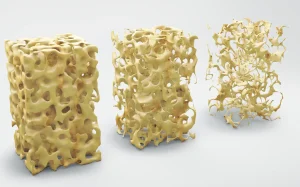BONE DISEASE
BONE DISEASE

Bone diseases encompass various conditions that impact skeletal health, from osteoporosis to osteoarthritis and bone infections. These conditions weaken bones, impair mobility, and increase fracture risk.
Symptoms include chronic pain, stiffness, inflammation, and limited daily activities. Diagnosis involves imaging, blood tests, and biopsies.
Treatments range from medications to surgery, complemented by lifestyle modifications and physical therapy.
Timely diagnosis, proper medical management, and prevention are crucial for managing bone diseases and preserving bone health. A balanced diet rich in nutrients supports bone health. Calcium and vitamin D, found in dairy, leafy greens, and fortified foods, are essential. Magnesium, phosphorus, vitamin K, and vitamin C from nuts, fish, whole grains, and citrus fruits are also important.
Prioritising a nutrient-rich lifestyle enhances quality of life while minimising the impact of bone diseases.
Description
Bone diseases refer to a diverse group of medical conditions that impact the structure, strength, and functionality of the skeletal system.
The skeletal system plays a vital role in supporting the body, protecting internal organs, and facilitating movement. Various factors can contribute to the development of bone diseases, including ageing, hormonal imbalances, poor nutrition, genetic predisposition, and certain underlying health conditions.
These conditions can lead to impaired bone density, increased fragility, and a higher risk of fractures. Symptoms of bone diseases may include bone pain, decreased mobility, deformities, fractures with minimal trauma, joint pain, and reduced height over time.
Early diagnosis and appropriate medical intervention are crucial in managing bone diseases effectively and minimising complications.
Treatment options vary depending on the specific condition but may involve a combination of medications, physical therapy, pain management techniques, and, in severe cases, surgical interventions. Additionally, adopting a healthy lifestyle that includes regular exercise, a balanced diet rich in bone-healthy nutrients like calcium, vitamin D, and magnesium, and avoiding tobacco and excessive alcohol consumption can provide valuable support in maintaining bone health and overall well-being.
Regular monitoring and ongoing medical management are essential to control symptoms, slow disease progression, and optimise the quality of life for individuals with bone diseases.
Bone diseases encompass a wide range of conditions that affect the structure, strength, and function of bones. Here's an explanation of the symptoms of bone diseases:
- Bone pain: Bone pain can be a common symptom of various bone diseases, including osteoporosis, osteoarthritis, bone infections, and bone tumours. The pain may vary in intensity and location, depending on the underlying condition.
- Misshapen bones: Some bone diseases, such as Paget's disease of the bone or skeletal dysplasias, can cause bones to grow abnormally, resulting in misshapen or deformed bones.
- Broken bones from low-energy or low-impact activities: A tendency to experience fractures from minimal trauma or low-impact activities may be indicative of weakened bones, as seen in osteoporosis or other conditions that reduce bone density and strength.
- Joint problems: Bone diseases can affect the joints, leading to symptoms like joint pain, stiffness, limited range of motion, and difficulty with activities that involve joint movement. Conditions like osteoarthritis and rheumatoid arthritis are examples.
- Headache: In some bone diseases, such as Paget's disease, bone tumours, or conditions affecting the skull, persistent or severe headaches may occur due to pressure on the surrounding structures.
- Hearing loss: Certain bone diseases can affect the bones of the inner ear, leading to hearing problems or gradual hearing loss. Conditions like otosclerosis can cause hearing impairment.
- Hip pain: Hip pain can result from bone diseases like osteoarthritis, avascular necrosis (loss of blood supply to the hip bone), or fractures of the hip bone, among others.
- Weakness: Bone diseases that lead to bone loss or muscle atrophy can result in overall weakness and reduced mobility.
- Sprains: While sprains primarily involve ligaments (the tissues connecting bones to each other), the instability of bones due to bone diseases can indirectly contribute to an increased risk of sprains.
Bone diseases encompass a wide range of conditions that affect the structure, density, strength, and overall health of bones. Here are some common types of bone diseases:
- Osteoporosis: Osteoporosis is characterised by reduced bone density and increased susceptibility to fractures. It often occurs due to an imbalance between bone formation and bone resorption, leading to weakened bones.
- Osteopenia: Osteopenia refers to bone density that is lower than normal but not yet severe enough to be classified as osteoporosis. It's considered a precursor to osteoporosis.
- Osteogenesis Imperfecta: Also known as "brittle bone disease," this genetic disorder causes bones to be extremely fragile and prone to fractures even from minor trauma.
- Paget's Disease of Bone: Paget's disease leads to abnormal bone remodelling, causing bones to become enlarged, weak, and prone to fractures.
- Rickets: Rickets is a condition primarily seen in children due to vitamin D deficiency or impaired metabolism. It results in soft, weak bones that are prone to deformities.
- Osteomalacia: Similar to rickets, osteomalacia is a condition where bones become soft and weak in adults. It's typically caused by vitamin D deficiency or problems with calcium metabolism.
- Fibrous Dysplasia: Fibrous dysplasia is characterised by the replacement of normal bone with fibrous tissue, leading to weakened bones and increased risk of fractures.
- Multiple Myeloma: Multiple myeloma is a type of blood cancer that affects plasma cells in the bone marrow. It can weaken bones and cause bone pain.
- Bone Cancer: Primary bone cancer originates in the bones and can lead to bone destruction and fractures. Secondary bone cancer refers to cancer that has spread to the bones from other parts of the body.
- Ankylosing Spondylitis: This inflammatory condition primarily affects the spine and can lead to fusion of the vertebrae, resulting in decreased flexibility and mobility.
- Avascular Necrosis: Avascular necrosis occurs when blood supply to a bone is disrupted, causing bone tissue to die and leading to joint pain and deformity.
- Hyperparathyroidism: Hyperparathyroidism can cause excessive levels of parathyroid hormone, leading to increased calcium loss from bones and weakened bones.
- Osteoarthritis: Osteoarthritis is a degenerative joint disease that can affect the cartilage in joints, including those in the spine and hips.
- Ewing Sarcoma: Ewing sarcoma is a rare type of bone cancer that primarily affects children and adolescents, leading to bone pain and fractures.
- Osteogenesis Imperfecta: Osteogenesis Imperfecta (OI), also known as "brittle bone disease," is a genetic disorder characterised by fragile bones that are prone to fractures. It's caused by mutations in genes responsible for producing collagen, a protein essential for bone strength.
- Osteonecrosis: Osteonecrosis, also known as avascular necrosis, occurs when there's a disruption in the blood supply to a bone, leading to bone tissue death. It often affects joints and can cause pain, limited mobility, and eventually joint collapse.
- Osteomyelitis: Osteomyelitis is an infection of the bone usually caused by bacteria. It can result from the spread of an infection from another part of the body or from direct bone injury. Symptoms include pain, swelling, and fever.
- Kashin-Beck Disease: Kashin-Beck disease is a rare, chronic disorder that primarily affects the joints and bones, particularly in regions with selenium-deficient soils. It can lead to joint deformities and growth impairments in children.
Bone diseases can have various underlying causes, and the specific cause often depends on the type of bone disease. Here's an explanation of the common causes associated with bone diseases:
- Genetics: Genetic factors can play a significant role in the development of bone diseases. Some individuals may inherit genetic mutations that predispose them to conditions like osteogenesis imperfecta (brittle bone disease), which affects bone strength and structure.
- Bad nutrition: Poor nutrition, especially a lack of essential nutrients like calcium, vitamin D, and protein, can weaken bones and lead to conditions such as osteoporosis. Insufficient nutrition during childhood and adolescence can also impact bone development.
- Ageing: Ageing is a natural factor that can contribute to bone diseases. As people age, bone density tends to decrease, increasing the risk of conditions like osteoporosis. Age-related changes in bone density and structure can make bones more susceptible to fractures.
- Bone remodelling disorders: Bone remodelling is the process by which old bone tissue is replaced with new bone tissue. Disorders of bone remodelling can disrupt this process, leading to conditions like Paget's disease of the bone, where bones become enlarged and deformed.
- Hormonal alterations: Hormones play a crucial role in maintaining bone health. Hormonal imbalances, such as a decrease in oestrogen during menopause or hormonal disorders like hyperparathyroidism, can affect bone density and structure.
- Side effects of some medications (corticosteroids): Long-term use of medications like corticosteroids, often prescribed for conditions like asthma or autoimmune diseases, can lead to bone loss and increase the risk of fractures. This condition is known as medication-induced osteoporosis.
- Lack of exercise: Physical activity is essential for maintaining bone health and strength. A sedentary lifestyle or lack of weight-bearing exercise can contribute to decreased bone density and an increased risk of bone diseases like osteoporosis.
- Infections: Certain infections, such as osteomyelitis (bone infection), can affect the bones directly, leading to bone diseases characterised by inflammation, pain, and bone damage.
- Injury or trauma: Traumatic injuries, such as fractures or dislocations, can cause long-term complications and potentially lead to bone diseases if not properly treated or if healing is impaired.
The choice of medication and treatment approach depends on the specific bone disease, its severity, and the patient's individual circumstances. Here's an explanation of some medical approaches:
- Bisphosphonates: Bisphosphonates are a class of medications used to treat bone diseases, particularly osteoporosis. They work by slowing down the breakdown of bone tissue and helping to maintain bone density. Common bisphosphonates include:
Alendronate (Fosamax, Binosto)
Risedronate (Actonel, Atelvia)
Ibandronate (Boniva)
- Zoledronic acid (Zometa, Reclast): Zoledronic acid is a medication often used to treat bone diseases, including osteoporosis and bone metastases from certain cancers. It belongs to the bisphosphonate class of drugs and is typically administered intravenously.
- Pamidronate (Aredia): Pamidronate is another bisphosphonate medication used to treat conditions like Paget's disease of the bone and hypercalcemia (elevated calcium levels) associated with cancer. It is administered intravenously.
- Analgesics: Analgesic medications, such as non-steroidal anti-inflammatory drugs (NSAIDs) or prescription pain relievers, may be prescribed to manage bone pain and discomfort associated with bone diseases. These medications can help alleviate pain and improve the quality of life for individuals with bone conditions.
Natural approaches and lifestyle habits can complement medical treatment and promote bone health in individuals with or at risk of bone diseases. Here's an explanation of the natural treatment options:
- Consume a balanced diet rich in essential nutrients: Proper nutrition is crucial for maintaining bone health. A diet that includes calcium, vitamin D, vitamin K, magnesium, and phosphorus can support bone density and strength. Foods like leafy greens, nuts, and fortified foods can provide these essential nutrients.
- Prevent the risk of falls: Preventing falls is essential for reducing the risk of fractures, especially in individuals with bone diseases. Measures to prevent falls include keeping walkways clear, using handrails, wearing appropriate footwear, and addressing any home hazards.
- Weight-bearing exercises: Weight-bearing exercises, such as walking, jogging, dancing, and weightlifting, can help strengthen bones and improve bone density. Regular physical activity can also enhance balance and reduce the risk of falls.
- Good sleep habits: Quality sleep is essential for overall health and well-being, including bone health. Adequate sleep allows the body to repair and regenerate bone tissue. Establishing good sleep hygiene practices can promote restorative sleep.
- Acupuncture: Acupuncture is a traditional Chinese therapy that involves inserting fine needles into specific points on the body. Some people find acupuncture helpful for managing pain associated with bone diseases and improving overall well-being.
- Tai chi: Tai chi is a mind-body practice that combines gentle, flowing movements with deep breathing and relaxation techniques. Tai chi can improve balance, flexibility, and strength, which are essential for preventing falls and maintaining bone health.
- Sun exposure: Adequate sun exposure can stimulate the body's natural production of vitamin D, which is essential for calcium absorption and bone health. Spending time outdoors and getting sunlight on the skin can help maintain vitamin D levels.
- Stress management: Chronic stress can have negative effects on bone health. Stress management techniques, such as mindfulness meditation, deep breathing exercises, and relaxation practices, can help reduce stress and promote overall well-being.
- Staying well hydrated: Proper hydration is important for overall health, including bone health. Water supports the body's various physiological processes, including those involved in maintaining bone tissue.










